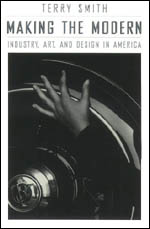
Making the Modern: Industry, Art, and Design In America (1993)
by Terry Smith
Synopsis: Smith asks: "Is there an iconography of modernity?" In investigating this, Smith explores the interconnecting forces that produced this iconography in the 1920-30s in the U.S. He states: "I explore the emergence, shaping, transformation, and then normalization of this visual order in a series of connected case studies, anything from the first Ford Motor Company plant at Highland Park, Detroit, commenced in 1910, to the New York World's Fair of 1939-40" (2). The book is divided into 4 parts: Part 1: The Modernization of Work: Detroit, 1910-1929 (River Rouge Plant and the rise of managerial observation; mass production functionalism and its influence on design; Charles Sheeler's art=functionalism can be beautiful); Part 2: Modernization and National Dissensus: Imagery of Reality in the 1930s (modernism became the style of the new corporatism; Diego Rivera's murals as depicting human side of industrial order; Frida Kahlo and gender imagery; FSA photos and the rise of "visualizing the people;" rural decline as flip-side of modernity); Part 3: Design or Revolution? Styling Modernity in the 1930s (androgynous "streamlined" shape; industrial designs hearkening a "usable future;" NY MOMA and NY World's Fair; Part 4: The Modern Effect )Modernity normalized and domesticated by 1940s, lost utopian bent due to horrors of various WWII realities). Argument is that modernity is all about severing ties with the past and creating something new. The modernist style is ultimately a triumph of corporate capitalism and the assembly-line aesthetic, and this whole thing demonstrates the interconnection of industry, New Deal agencies, art, and design. The role of visual imagery in the so-called Second Industrial Revolution ultimately "altered the way Americans saw themselves, saw others, and were seen by others" (2).
Interesting Specifics:
The 1920s-30s were especially concerned with the symbolic, and if fact many people were annoyed by modernity's "excesses, its sensationalized violence, its oversignification" (322).
Six images constantly occurred at this time: "industry and workers, cities and crowds, products and consumers" (7).
The huge River Rouge plant in Detroit was developed between 1915-25.
"Functionalism is essential to modernity" (72).
"Streamlining" was industrial design's biggest contribution, and the egg-like smooth shapes created an imagery of vague androgyny (380). [Interesting, but wasn't "modernity" all about the masculine, and the dispelling of the female? Maybe this was a way to bring the female back - after the rise of the skyscraper - in a subtle way].
Modernity lost a lot of its utopian value after WWII, probably due to the rising belief that machines would be bad too (i.e. connection between social planning and Nazism).
Modernism as triumph of corporate capitalism.
Mass production demanded an imagery which would be reflected in buildings too; it got this in post-Art Deco Moderne (92).
1914 = Ford introduces his $5 a day wages plan (idea being that workers could then buy more Ford stuff).
Model A = 1927.
Charles Sheeler was a famous photographer and painter of new industrial plants and modernist landscapes. He did much to open up the public eye to the beauty of functionalism and the idea that industrial order could be beautiful.
Photography was the dominant visual form of the 1930s.
Interacts With:
Twentieth Century Limited,

No comments:
Post a Comment